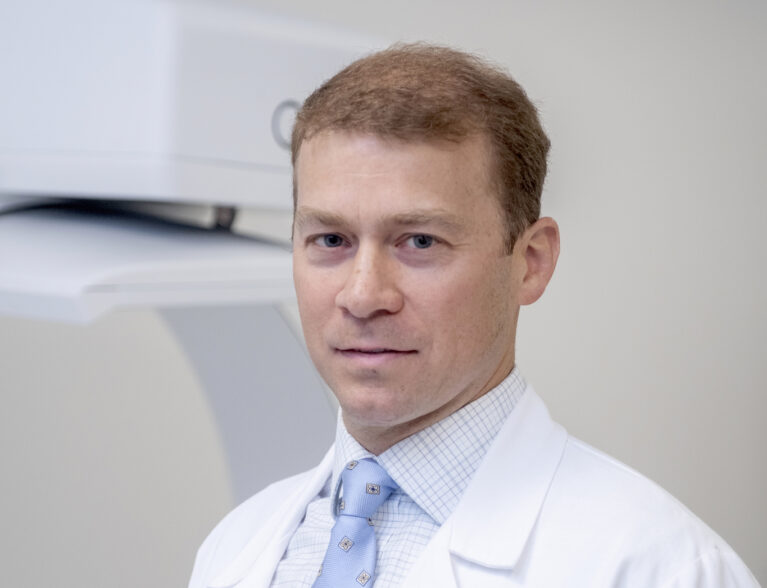
Brachytherapy, a precise form of radiation therapy used to treat a range of cancers, has emerged as a promising option for certain skin cancer patients, offering an alternative to traditional methods like Mohs surgery. By delivering high doses of radiation directly to the cancerous tissue, brachytherapy minimizes damage to surrounding healthy skin.
“Brachytherapy is a way of delivering radiation with a radioactive isotope that’s attached to the end of a long wire,” Dr. Ellis Ziel, radiation oncologist with Cleveland Clinic Indian River Hospital, explained. “The wire is mechanized or controlled by a robot that shifts it in and out of various applicators. We can shape the applicator to various skin lesions.
“The radioactive source goes inside of the applicator and delivers the radiation directly to the tumor. We’ve got molds that we can shape across large tumors, like an ear with an irregular surface or a nose, or even a large tumor on a shoulder. The mold is on top of the tumor covering the entire surface. It’s very precise. We can tell that source exactly where to go and make sure it doesn’t go on top of area of skin where we don’t want it.
“We have pre-shaped applicators in various sizes which we use for many smaller tumors, but for larger lesions that are irregular, we can shape the applicator to whatever shape we need. We used customized mold applicators that we can construct here in the department and even have the capability to use 3-D printed molds depending on what works best for the patient.”
One of the primary advantages of brachytherapy is its minimally invasive nature. Unlike Mohs surgery, which involves physically removing layers of skin, brachytherapy uses targeted radiation to destroy cancer cells. This makes it a viable option for patients who are not good candidates for surgery.
“The procedure is non-surgical, so when the radiation is being administered, the patient can’t feel it,” Dr. Ziel said. “They can feel the applicator but not the radiation itself. There’s no warmth, no tingling and no pain, and they can walk out of the clinic without any bandages because there is no bleeding. You leave the clinic with no restrictions. In most cases, the patient can resume their daily activities, including swimming, without interruption.”
Another advantage is brachytherapy’s precision targeting. The radiation is delivered directly to the tumor while sparing the surrounding healthy tissue, reducing the risk of damaging nearby structures, especially in sensitive areas like the face, ears, or nose where cosmetic concerns are crucial. Brachytherapy can result in fewer visible scars than surgical methods.
While the treatment is quick and non-invasive, it does require more than one treatment.
“Depending on the size and location of the tumor, we recommend the patient come in for a minimum of six treatments and sometimes as many as 10 for larger tumors,” Dr. Ziel continued.
“Treatments are done two or three times a week, but each treatment can be completed in less than 30 minutes. And, in some cases we can treat more than one location at the same time.”
Multiple large studies have demonstrated that HRD brachytherapy is an effective non-surgical treatment option for early-stage non-melanoma skin cancer with equivalent recurrence rates and cosmetic outcomes to Mohs micrographic surgery in appropriately selected patients at extended follow up. It is endorsed by the National Comprehensive Cancer Network and considered particularly effective for skin cancers in the head and neck region.
Recurrence rates are also about the same with brachytherapy and Mohs surgery, approximately 5 percent long-term.
While brachytherapy is highly effective for certain types of skin cancers, it is not suitable for all cases. It’s typically limited to superficial or smaller, localized cancers such as basal cell carcinoma or squamous cell carcinoma.
Larger, deeper cancers and aggressive forms like melanoma may require more invasive approaches such as surgeries more extensive than Mohs surgery or more complex forms of radiation therapy.
The decision on whether to use brachytherapy or surgery should be made after a discussion with your dermatologist, surgical and/or oncology team.
“Here at Cleveland Clinic, we are a multidisciplinary team, and we’ve got a great group of dermatologists who perform Mohs surgery, but we also have radiation oncologists trained specifically in oncologic principles and radiation techniques,” Dr. Ziel said.
“Radiation is a great option, but if we decide surgery is a better solution then we refer the patient over to surgery. I always recommend exploring both options before deciding which procedure is best for you.”
Because of the specialized equipment needed for Brachytherapy the cost can be higher than for surgery. However, it is a standard of care treatment so if your physician recommends this treatment most insurance providers will cover the cost.
Those considerin+_+g brachytherapy should consult with a radiation oncologist to carefully weigh the benefits and drawbacks based on their specific type of cancer and overall health.
Dr. Ellis Ziel received his medical education at the University of Alabama School of Medicine and completed his internship in Preliminary Internal Medicine at the University of California Irvine.
His residency in Radiation Oncology was completed at Rush University Medical Center in Chicago, and his fellowship in Brachytherapy-Radiation Oncology was completed at Ronald Reagan UCLA Medical Center in Los Angeles. His office is located in the Scully Welsh Cancer Center at Cleveland Clinic Indian River Hospital, 3555 10th Court, Vero Beach. You can call 772-563- 4673 for an appointment.



